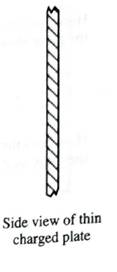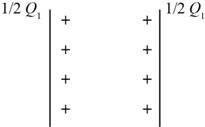
Concept explainers
A small portion near the center of a large thin
Write an expression for the charge density on each side of the conducting plate.

The expression for charge density on each side of the conducting plate.
Explanation of Solution
Introduction:
The charge density is the ratio the charge distributed over a surface area. The expression for the charge density is given by,
The distribution of the charge on the plate is shown below,

Figure 1
Now, because plate in uniform and charge on both the sides is same. So, the charge density on both the sides of the plate if the area of the sides is
Conclusion:
Therefore, the expression for the charge density on each side of the plate is
Want to see more full solutions like this?
Chapter 5 Solutions
Tutorials in Introductory Physics
Additional Science Textbook Solutions
University Physics (14th Edition)
An Introduction to Thermal Physics
Physics for Scientists and Engineers: A Strategic Approach with Modern Physics (4th Edition)
The Cosmic Perspective (8th Edition)
Essential University Physics: Volume 1 (3rd Edition)
College Physics (10th Edition)
- The inner radius shown in the figure 1m, outer radius 2m and charge density 3 µC Consider the surface charge distributed across the disk. Since the medium is empty m2 space, (a) Find the total charge on the disk. (b) 10m above the axis of the load P to the point 2 [µC|lf a load of is placed, find the force that will act on this load. P(0,0,10m) 2m 1m Psarrow_forwardCharge is distributed throughout a spherical volume of radius R with a density p = ar², where a is a constant (of unit C/m³, in case it matters). Determine the electric field due to the charge at points both inside and outside the sphere, following the next few steps outlined. Hint a. Determine the total amount of charge in the sphere. Hint for finding total charge Qencl = (Answer in terms of given quantities, a, R, and physical constants ke and/or Eg. Use underscore ("_") for subscripts, and spell out Greek letters.) b. What is the electric field outside the sphere? E(r> R) = c. What is the electric field inside the sphere? Hint for E within sphere #3 Question Help: Message instructor E(r < R) = Submit Question E с $ 4 R G Search or type URL % 5 T ^ MacBook Pro 6 Y & 7 U * 8 9 0 0arrow_forwardRefer to the picture below. A positive static charge +10q is placed (not exaclty in the center) inside a conducting shell. The conductor has a net charge of +8q. Determine the charge on the conductor's outer surface. Pick answer and give explanation.arrow_forward
- A non-uniformly charged insulating sphere has a volume charge density p that is expressed as p= Br where B is a constant, and r is the radius from the center of the sphere. If the, the total charge of the sphere is Q and its maximum radius is R. What is the value for B? Sol. By definition, the volume charge density is expressed infinitesimally as p= where in is the infinitesimal charge and is the infinitesimal volume. so, we have P = dq/ = B so we can write this as dq = B dV But, dV = dr By substitution, we get the following dq = 4B dr Using Integration operation and evaluating its limits, the equation, leads to Q = Rearranging, we get B = 4)arrow_forwardA non-uniformly charged insulating sphere has a volume charge density p that is expressed as p= Br where B is a constant, and r is the radius from the center of the sphere. If the, the total charge of the sphere is Q and its maximum radius is R. What is the value for B? Sol. By definition, the volume charge density is expressed infinitesimally as p= where in is the infinitesimal charge and is the infinitesimal volume. so, we have p = dq/ So we can write this as dq = B dV %3D But, dV = drarrow_forwardA non-uniformly charged insulating sphere has a volume charge density p that is expressed as p= Br where B is a constant, and r is the radius from the center of the sphere. If the, the total charge of the sphere is Q and its maximum radius is R. What is the value for B? Sol. By definition, the volume charge density is expressed infinitesimally as p= where in is the infinitesimal charge and is the infinitesimal volume. So, we haye p = dq/ So we can write this as dq = B dV But, dV = dr By substitution, we get the following dq = 4BT dr Using Integration operation and evaluating its limits, the equation, leads to Q = BT Rearranging, we get B = /( Tarrow_forward
- = Adx. Then find the net field by integrating dE over the length of the rod. Use the following as The charge per unit length on the thin rod shown below is 2. What is the electric field at the point P? (Hint: Solve this problem by first considering the electric field dE at P due to a small segment dx of the rod, which contains charge . necessary: L, a, 2, and ɛn. Enter the magnitude. Assume that A is positive.) L A 1 E = 4ne L+A aarrow_forwardA solid conducting cylinder, which has a charge Q1 =69Q and radius ra = 1.2R is placed inside a very thin cylindrical shell of radius rp = 4R and charge Q2 =-6Q as shown in the figure below. R Q1 Find the magnitude of the electric field at r=5.4R. Express your answer using one decimal point in units of TTE,RLarrow_forwardA solid insulating sphere of radius 5 cm carries electric charge uniformly distributed throughout its volume. Concentric with the sphere is a conducting spherical shell with no net charge as shown in the figure below. The inner radius of the shell is 10 cm, and the outer radius is 15 cm. No other charges are nearby. A sphere is enclosed by and concentric with a larger spherical shell. The sphere and shell are separated by empty space. Four points are lined up horizontally and labeled as follows. Point A is inside the sphere. Point B is in the empty space between the sphere and shell. Point C is in the interior of the shell. Point D is outside of the shell. (a) Rank the magnitude of the electric field at points A (at radius 4 cm), B (radius 8 cm), C (radius 12 cm), and D (radius 16 cm) from largest to smallest. Display any cases of equality in your ranking. (Use the letters A, B, C, and D to rank the magnitude. Use only ">" or "=" symbols. Do not include any parentheses around…arrow_forward
- The figure below shows part of an infinitely long, nonconducting line of charge with uniform positive charge per unit length ?. Determine the magnitude E of the electric field at a distance r from the line. Your answer should be expressed in variable form. (Use the following as necessary: ?, r, and ?0. Do not substitute numerical values; use variables only.)arrow_forwardYou have the same line of charge in the previous problem (with +6.00 nC of charge on it). But now you are measuring the electric field 1.5 m above the center of the rod – see image below. Predict the electric field at Point P in this diagram. Make sure to include a direction with your answer.arrow_forwardThe charge per unit length on the thin rod shown below is A. What is the electric field at the point P? (Hint: Solve this problem by first considering the electric field dE at P due to a small segment dx of the rod, which contains charge dq = Adx. Then find the net field by integrating dE over the length of the rod. Use the following as necessary: L, a, A, and ɛn: Enter the magnitude. Assume that A is positive.) E =arrow_forward
 Physics for Scientists and Engineers: Foundations...PhysicsISBN:9781133939146Author:Katz, Debora M.Publisher:Cengage Learning
Physics for Scientists and Engineers: Foundations...PhysicsISBN:9781133939146Author:Katz, Debora M.Publisher:Cengage Learning Principles of Physics: A Calculus-Based TextPhysicsISBN:9781133104261Author:Raymond A. Serway, John W. JewettPublisher:Cengage Learning
Principles of Physics: A Calculus-Based TextPhysicsISBN:9781133104261Author:Raymond A. Serway, John W. JewettPublisher:Cengage Learning

